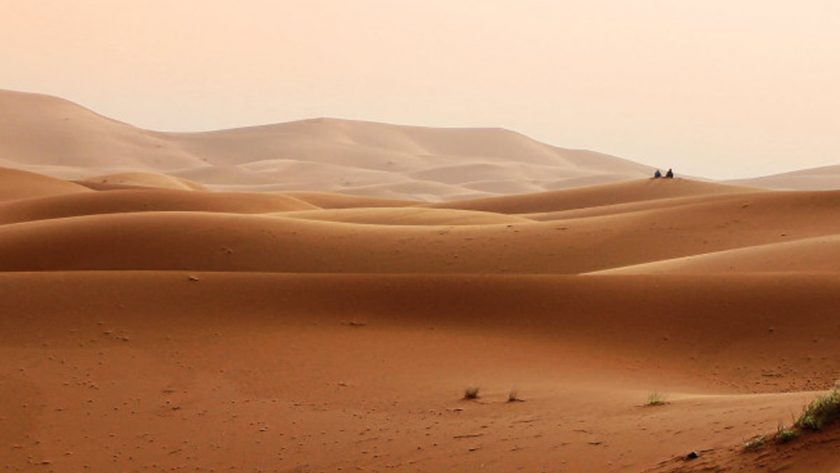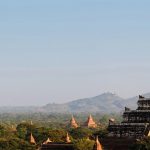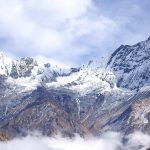Lost in Mongolia’s Gobi Desert, Leonid Plotkin ponders the dusty path that has led him there – and that may not lead him out.
“Did you know Mongols call this car the vacuum cleaner?” offered Omboo, my white-gloved chauffeur, as we rumbled along rutted dirt tracks – Mongolia’s highways – in his UAZ, a kind of jeep, the modernized version of a 1941 Russian military design.
“Why?” I asked, stirring reluctantly in the heat and taking a bite of some suspended sand particles.
“Because you drive it around, and it sucks in all the dust from the road.”
Without warning, the brakes squealed; the car pitched forward and slid to a halt. The cloud of desert dust that had trailed the jeep enveloped us on all sides and hung in the hot, motionless air. “Dorogu poteryali,” Omboo mumbled in Russian. “We’ve lost the road.” In the sweltering stillness, my torpor turned into anticipation. Who doesn’t dream of the desert? Not that I’d yearned to get lost in the Gobi, but the specter of a struggle for self-preservation lent sudden consequence to my St. Petersburg-to-Singapore overland schlep. It seemed pointless sometimes, this two-year journey. Now I had purpose.
For days we had been bumping around in Omboo’s gray UAZ. Drivers venturing into remote rural Mongolia liked the UAZ because it was simple. Russian engineers had taken the idea of a jeep and reduced it to its bare essentials, dispensing with frivolities like adjustable seats and windows that open. It was, perhaps, perfectly suited for a short soldier driving in Siberian snow. I was six-foot-four. The summer sun was white. The car had me cursing. But Omboo had assured me that without any help he could deconstruct, repair, and reassemble the UAZ. That’s why I’d hired him in Ulan Baatar.
“Oh, James,” I muttered under my breath. “James” seemed fitting for a white-gloved chauffeur. At times, I assumed the part of an English aristocrat, exhorting him, “Drive gently, James!” whenever the car lurched into motion. Truth be told, Omboo was no James. He was an engineer, an educated man who recited Russian poetry and recommended Mongolian literature: The Secret History of the Mongols, a 13th-century work of prose and poetry, and the modern novel The Clear Waters of the Tamir. Mongolia’s small industrial complex had collapsed in the early ’90s with the bankruptcy of its only customer, the USSR. Engineers became superfluous, and now Omboo earned a living trucking tourists around Mongolia.
He removed his aviator shades and one of his gardening gloves, then drew the glove across his features, smearing the sweat-and-soil batter covering his face. I unwedged my knees from the dashboard, took some tepid bottled water to wash the grit from my mouth, and peered into the glare and the yawning emptiness all around. Desert! Stones, sand dunes, hillocks – and no signs of “road.”
The Evocative Empty Quarter
The landscape of rural Mongolia appears unviolated, unexploited, untouched by man. This timelessness, the virtual absence of anything to remind you that you are not in the last century or even in the century of the Great Khan, is Mongolia’s defining and most unforgettable feature. No houses, no fences, no farm fields, no factories, no roads.
Mongolia is a place to ponder vast blocks of time. Nothing interrupts the sightlines or distracts from the gradually changing panoramas of sky, hill, sand, and grass. Standing in front of the UAZ, I looked down at a small plot of earth – abiding, parched, and forlorn – and I imagined the footsteps that trod here: khans’ armies, caravans from Tibet, explorers. Following the land’s undulations, my gaze drifted up to the horizon, to distant hills deeper in the remoteness of inner Asia. I longed for what lay just beyond.
The romance of travel remains, but even in remotest Mongolia, one cannot surrender to it completely. The intermittent automobile, the occasional row of wooden telephone poles running to the horizon, and the solar-powered satellite-TV dish next to the nomad’s yurt sometimes intruded on my reveries and brought me back to my own era.
Omboo and I scanned the distance for signs of human presence. We were far from permanent settlements, but half of Mongolia’s population, more than a million people, remains nomadic. Spread out across a land three times larger than France, they tend their six treasures: horse, yak, camel, cow, sheep, and goat. Though we couldn’t see them, it was possible people were nearby.
Travelers From Birth
In recent days, we had crossed paths with families on the move in search of water and pasture, all their possessions roped on the backs of three or four shaggy Bactrian camels. Why, I wondered, did they eschew the more elaborate life of the towns and the conveniences of the city? No doubt economic factors play a role. Urban life in Mongolia means expensive housing and unemployment. In the countryside, there is no landlord – each man is his own master, free to wander and make use of the land. Still, I hoped that the persistence of nomadism could not be reduced to mere economics, that there still existed cultural or psychological reasons to explain why the nomads choose this harsh but unfettered existence. I was searching for precedents, for I had made that choice myself, abandoning a comfortable situation in New York to take to the road, and sometimes I struggled to articulate what made that decision correct.
Occasionally I comforted myself with the notion that my wanderlust was inevitable. The writer Bruce Chatwin theorized that “Evolution intended us to be travelers.”
“Prolonged settlement has a vertical axis of some ten thousand years,” he wrote, “a drop in the ocean of evolutionary time. We are travelers from birth.” Biological imperative made me travel!
Still, it was hard to overlook the fact that most people in the world seem perfectly content to stay put. Does Mongolian culture allow for the expression of an urge suppressed by settled civilizations? Some academics dismiss such musings as “atavistic stereotypes about originary cultural states.” This misses the point. Having grown up in the West, I would not choose the life of a Mongolian nomad. Their way of life interests me as a counterpoint. As I roamed around the Gobi, the idea of permanently dispensing with certain comforts in order to live a more unbound, more sensory, more spontaneous existence had great hold on my mind – travel not as temporary escape but as a way of life.
But the nomads I spoke with had nothing to say about this abstract concept. They simply told me they liked to look out the yurt’s door and see steppe and sky. Just like suburban Americans, they reacted with disapproval when I described my small studio apartment in New York.
Culture Clash
Omboo reacted with tense calm and increasing unease to finding himself directionless. He had not come to the Gobi to discover the unfamiliar. I hoped for unpredictability and adventure; he wanted nothing more than to earn a living and return safely home to his wife. Uncertainty filled me with vitality; in Omboo it inspired only dread.
“We’ll find our way,” I said, smiling.
His eyes narrowed, and he addressed me the way one would speak to a fool or a little child: “You must respect the land. Do not imagine you are its master.”
Perhaps it was hubris, but after a few moments’ reflection, giving deference to the desert’s power, I still concluded there was no cause for concern. We had enough bottled water, pasta, and canned Estonian sprats in the UAZ to last us a month. Someone would stumble upon us by then. Or we would seek someone out. People live spread thinly across the vastness, but one rarely needs to drive more than a few hours before a white, pill-shaped yurt pops up on a far-off hill. The intense sensation I had just experienced began ebbing away as I grew more comfortable with our situation. My excitement shrank to mild disappointment.
Many travelers like to imagine their journeys as heroic; but there is no heroism and little real danger in this age of travel. The global tourism infrastructure, Lonely Planet, and people’s generally kind disposition to the lone wanderer ensure that, when circling the Earth, one is unlikely to suffer anything worse than delay, discomfort, or inconvenience.
Omboo pulled on his glove. “Drive gently, James,” I said with a sigh, and we began bouncing across the desert floor, barely in control on the unpredictable surface, zigzagging between rocks and crevices, running roughshod over little bushes. Slight and bird-chested, Omboo struggled with the heavy steering wheel. Amid swirls of powdered dirt, the car whined in first gear up steep hills. From each elevated spot, we searched the badlands for yurts. One gleamed in the distance, and we crawled along toward it, descending into a trough between hills and losing sight of it, driving on, ascending a crest and again catching a glimpse – only to arrive, after a long and tortuous path, at a massive, sun-bleached boulder.
A couple hours’ more plodding, and we pulled onto a plateau. Through squinting eyes and binoculars, we focused deep into the distance – arguing about whether features swimming and shimmering on hot air currents were yurts, rocks, or mirages. Grazing goats grabbed our attention. Omboo and I turned to each other with a look of agreement – where there are goats, there are goatherds. We followed the goats; there were no goatherds. Irritated, lips pressed together in aggravation, Omboo swerved in another direction and drove on. Finally, after some hours of aimless roving, we chanced on a yurt.
Tie Up Your Dogs!
Navigating the UAZ with one gloved hand as we rolled up to the yurt, Omboo’s confidence returned, and he slipped on his sunglasses – again half-gangster, half-gardener. The future shone brightly, even as three slavering yellow mongrels shook the desert dust from their hides and surrounded the car. Some young girls played in the sand. Grinning, Omboo cut the motor, carefully cracked open the door, and in his strained, high-pitched voice wailed the standard greeting of rural Mongolia: “Nakhoi khoroe! Tie up your dogs!” The children held the murderous mutts but could do little more. There was no one else around, and these kids knew nothing of roads. They pointed us in a direction where we could find others.
Following the girls’ advice, we skirted a nearby hill and found some people working with sheets of canvas and wet wool to create the felt used to insulate yurts. A stocky, broad-shouldered nomad, his face red from sun and exertion, exuded commanding presence. Omboo and the commander conferred. Crouching low to the ground, using their index fingers, they scratched lines and scrawled schematics in the dirt, then wiped away the results and doodled again. The landscape here had no distinguishing features or anything that looked like a landmark. I regarded the mapmakers with bemusement and incredulity. But a half-hour later, we found ourselves back on the “road,” and Omboo, visibly relieved to have a clear track to follow, set the UAZ on its course.
Delighted that no paleoanthropologist in the distant future would be excavating my fossilized bones from the Gobi, I nonetheless regretted that things had not grown more interesting. My desert adventure had proved predictably short. Still – cruising in the convulsing UAZ, enveloped in the eternal land that lay all about, I knew I had done right to come to Mongolia. In this large, evocative landscape I had felt a connection to a long past, to history and humanity – to something greater than my own small life.



